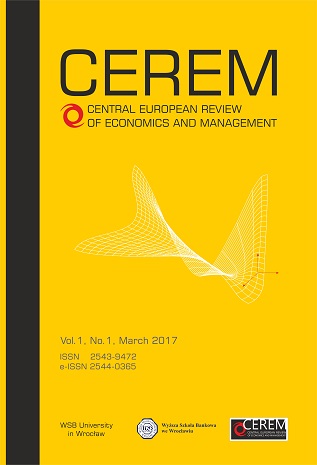Planning a market exit strategy for manufacturers of consumer goods when entering foreign markets
DOI:
https://doi.org/10.29015/cerem.90Abstrakt
Aim: The internal market for manufacturers of consumer products companies is often too small in order to grant long-term success. Therefore, companies expand and enter foreign markets. This paper presents a planning process for market penetration for the selected foreign market, which will show the possibility of a withdrawal and shows also whether an exit scenario is planned by manufacturers of consumer products and when companies tend to think about a market exit.
Design / Research methods: First, the literature was studied. Based on this, hypothesis were prepared. This was followed by a telephone survey of decision-makers from German manufacturers of the consumer products companies.
Conclusions / findings: A planning process for market penetration was developed, which shows next to the market entry also the market exit. Additional this paper shows that manufacturers of consumer products companies can be better prepared for a market exit than companies without an exit strategy, in particular, if the manufacturer sets out relevant economic parameters for the foreign market which determine whether to remain in the market or leave.
Originality / value of the article: When analysing literature on planning processes for market entry, it becomes clear that an exit strategy is not planned. This may indicate that the authors did not consider a market exit and/or anticipate this as a worst case in their market entry assumption.
Implications of the research: The last market entry of the surveyed companies usually occurred recently. For market exit results to be determined, a further consultation of the companies examined should be undertaken over a longer period of time.
Pobrania
Opublikowane
Numer
Dział
Licencja
Autor przenosi nieodpłatnie na Wyższą Szkołę Bankową we Wrocławiu , bez ograniczeń terytorialnych, majątkowe prawa autorskie do tego utworu w rozumieniu ustawy z dnia 4 lutego 1994 roku o prawie autorskim i prawach pokrewnych ( Dz.U. 1994, Nr 24, poz. 83 ze zm. )na zasadzie wyłączności, tj. prawo do:
a) wyłącznego używania i wykorzystania utworu w dowolnej działalności przez Wyższą Szkołę Bankową we Wrocławiu, w szczególności w działalność Biblioteki Cyfrowej uruchomionej przez Wyższą Szkołę Bankową we Wrocławiu
b) wytwarzania, utrwalania i zwielokrotniania egzemplarzy utworów wszelkimi technikami, w tym techniką drukarską, reprograficzną, zapisu magnetycznego oraz techniką cyfrową, w szczególności ich zwielokrotniania poprzez dokonywanie zapisów na płytach typu CD,
c) zamieszczenia wybranych fragmentów utworu w celach promocyjnych w publikacjach, materiałach promocyjnych, w sieci Internet oraz sieciach wewnętrznych typu Intranet Wyższej Szkoły Bankowej we Wrocławiu,
d) wprowadzania utworu do pamięci komputera Wyższej Szkoły Bankowej we Wrocławiu,
e) kopiowania i powielania utworu w technologiach fotomechanicznych lub innych znanych w dniu zawarcia umowy (fotokopie, kserokopie itp.),
f) przetworzenia dzieła na formę elektroniczną i nieograniczonego rozpowszechniania w sieci Internet.


